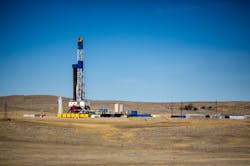The U.S. Geological Survey (USGS) increased its estimate of the potential reserves of natural gas in the Barnett Shale.
According to the latest estimate, the Texas shale basin contains mean volumes of 53 trillion cubic feet of shale natural gas, 172 million barrels of shale oil and 176 million barrels of natural gas liquids. This estimate is for undiscovered, technically recoverable resources and is double the USGS assessment for natural gas made in 2003.
That earlier assessment estimated a mean of 26.2 trillion cubic feet of undiscovered natural gas and 1.0 billion barrels of undiscovered natural gas liquids within the Barnett Shale. Potential oil resources were not quantitatively assessed for the Barnett at that time, USGS noted.
New drilling techniques are behind the substantial increase in potential resources, with the oil and gas industry switching to primarily horizontal drilling within the Barnett, paired with hydraulic fracturing.
The 2003 assessment was based solely on vertical drilling, but since then more than 16,000 horizontal wells have been drilled into the formation.
“We decided to reassess the Barnett Shale following the successful introduction of horizontal drilling and hydraulic fracturing, setting the stage for the current shale gas boom,” explained USGS scientist Kristen Marra, who led the assessment. “In addition, the newly revised assessment incorporates estimates for both gas and oil resources within the Barnett.”
USGS carried out the updated Barnett Shale assessment as part of a nationwide project assessing domestic petroleum basins using standardized methodology and protocol.
